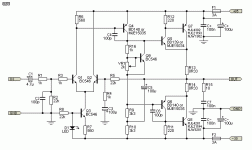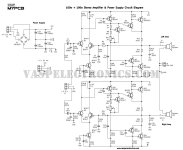So after my TDA7294 amp finally getting done with all the mods and options. I am now moving onto my P3A design. Full credit to Rod for his contribution to the DIY community.
So I purchased a few PCBs that are available to me in my country. Some are better than others. But all work.
My problem now is do I follow the values provided with these PCBs. Or do I follow the original design.
So far I have listed out the key areas of difference. I have then started to try each change one by one and see what sounds better and measures better.
But this is taking way too much time. Ideally I would like to just create a Simulation model. And keep changing values and seeing the results. Being new to Spice I can create the modell. But where I get lost is what parameters or commands would I need to monitor in the simulator.
If a spice expert could give me a starting point or list off commands to give spice.
I am attaching both schematics. The OG Rod vs the one I got with my local PCB.
In particular I'm curious about the value difference.
(When I first built this I kept blowing transistors. Then I had a lot of distortion).
All these problems were caused by fake components. The BD139 BD140 and main drivers were fake. One batch just failed. The other had a lot of distortion. No matter how bad the PCB is with the right components. This design just works.
The key areas where there is a huge difference in recommended values.
1. R3 / R39 = 470 ohms on Rods R6/R7=560 Ohms (I used 505.12 Ohms).
2. C2/C4 220uf/47uf on Rods C3/C5 100uf/100uf
3. R11/R12 = 220ohms on Rods R11/R12 100 ohms.
4. BC547 vs BC546 the implications. And I landed up using 2n2222 why because it sounded the best of all the ones I had on hand. Maybe psychological. lol.
There are a few other differences between the two schematics But I want to get to grips and understanding these 3 to start with.
If nobody responds. My backup plan is to just try both options measure noise and power output and just pick the one that sounds better to me. Im just curious were these values changed because they proved to work better or for some other reason.
So I purchased a few PCBs that are available to me in my country. Some are better than others. But all work.
My problem now is do I follow the values provided with these PCBs. Or do I follow the original design.
So far I have listed out the key areas of difference. I have then started to try each change one by one and see what sounds better and measures better.
But this is taking way too much time. Ideally I would like to just create a Simulation model. And keep changing values and seeing the results. Being new to Spice I can create the modell. But where I get lost is what parameters or commands would I need to monitor in the simulator.
If a spice expert could give me a starting point or list off commands to give spice.
I am attaching both schematics. The OG Rod vs the one I got with my local PCB.
In particular I'm curious about the value difference.
(When I first built this I kept blowing transistors. Then I had a lot of distortion).
All these problems were caused by fake components. The BD139 BD140 and main drivers were fake. One batch just failed. The other had a lot of distortion. No matter how bad the PCB is with the right components. This design just works.
The key areas where there is a huge difference in recommended values.
1. R3 / R39 = 470 ohms on Rods R6/R7=560 Ohms (I used 505.12 Ohms).
2. C2/C4 220uf/47uf on Rods C3/C5 100uf/100uf
3. R11/R12 = 220ohms on Rods R11/R12 100 ohms.
4. BC547 vs BC546 the implications. And I landed up using 2n2222 why because it sounded the best of all the ones I had on hand. Maybe psychological. lol.
There are a few other differences between the two schematics But I want to get to grips and understanding these 3 to start with.
If nobody responds. My backup plan is to just try both options measure noise and power output and just pick the one that sounds better to me. Im just curious were these values changed because they proved to work better or for some other reason.
Attachments
Last edited:

